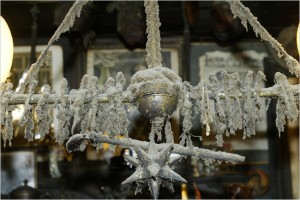McSorley’s Old Ale House, in the East Village, is not my favorite bar. The service is inevitably surly, the place is always in-your-face packed with tourists and frat boys, the smell is a bit on the musky side, and the weird little half-pints of beer only come in two varieties (brace yourself, Llalan), dark and light. They didn’t even let women in the front door until they were forced to do so in 1970. Basically, if the bar itself was a person, I probably wouldn’t like him much.
But I can’t help but hanker for an occasional trip to McSorley’s. Established (or at least allegedly established) in 1854, it’s one of the few places where you can still feel how old of a place Manhattan really is. If you could manage to elbow your way to a table and order up one of their cheese plates (The cheddar—so sharp! The onion—so raw! The mustard—so spicy!), you’d have a perfect vantage point of some weird artifacts of Old New York, like photos of long-gone drinking club members and antique fireman helmets and turkey wish bones hanging above the bar covered in decades of dust. You could eye those bones and, depending upon the story you chose to believe, think about the quirky bar owner who’d collected them or the WWI doughboys who never made it back from Europe to take them down. And, a little tipsy, you could have deep thoughts about death and decay and the long slog of time and wash it all down with a gulp of light. You could have, that is, until the health department stepped in last year.
In the ominously formal language of government, the health department strongly suggested that the unsanitary dust on the turkey bones be removed, and McSorley’s eventually caved to the threat, even though some of the bones crumbled away as they were cleaned. And now we can all feel a little more protected from dust as we get wasted.
I know, I know—we’re just talking about some old turkey bones here. But is history worth as much if it’s been sanitized? I often wrestled with this in Cambodia, where the ancient Khmer temples (especially the smaller, lesser-known ones) continue to be trampled and damaged by visitors. But then again, touching those stones and climbing those steps is where you can actually feel the blood and sweat and mystery of people who lived a thousand years before. Undoubtedly, a wealthier nation would have roped off the temples, thrown plates of glass in front of the carvings, put up hundreds of “do not touch” signs. And measures like that might prevent erosion and decay. But would the history of the temples lose something in the process?
I’m not completely comfortable with either option, but I do think that history is messy and bloody and decidedly unsanitary. And maybe staying in touch with those aspects of it is the only way we manage to learn anything useful or meaningful about our own past. Dust seems far less harmful than losing sight of that. So as I nibble my Tofurkey today, I’ll silently raise a glass to those bones at McSorley’s and the dust that is, even now, still settling upon them.

